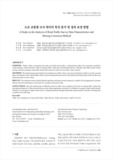

PARTNER
검증된 파트너 제휴사 자료
도로 교통량 조사 데이터 특성 분석 및 결측 보정 방법
방대한 850만건의 자료 중 주제별로 만들수 있는 최적의 산출물을 해피 캠퍼스에서 체험 하세요 전문가의 지식과 인사이트를 활용하여 쉽고 폭넓게 이해하고 적용할수 있는 기회를 놓치지 마세요
7 페이지
최초등록일 2023.12.18
최종저작일
2023.10

-
 * 본 문서는 배포용으로 복사 및 편집이 불가합니다.
* 본 문서는 배포용으로 복사 및 편집이 불가합니다.
미리보기
서지정보
· 발행기관 : 한국도로학회
· 수록지 정보 : 한국도로학회논문집 / 25권 / 5호
· 저자명 : 한대철, 문학룡, 변상철, 이상수
목차
1. 서론
2. 선행연구
3. 자료의 수집
4. 도로교통량 자료 보정법
4.1. 원시자료의 보정 여부 판단 기준
4.2. 보정기준 및 보정 방법 결정
4.3. 장기간 누락 보정 방법
5. 도로교통량 자료 특성 분석
5.1. 연도별 특성
5.2. 월별, 요일별, 교통량 오차율 비교
5.3. 이상치 정보 유형과 처리
6. 교통량 데이터의 보정 전후 특성
7. 결론
감사의 글영어초록
PURPOSES : Traffic volume, an important basic data in the field of road traffic, is collected from traffic survey equipment installed at certain locations, which sometimes results in missing traffic volume data and abnormal detection. Therefore, this study presents various missing correction techniques using traffic characteristic analysis to obtain accurate traffic volume statistics. METHODS : The fundamental premise behind the development of a traffic volume correction and prediction model is to set the corrected data as the reference value, and the traffic volume correction and prediction process for the outliers and missing values in the raw data were performed based on the set values. RESULTS : The simulation results confirmed that the algorithm combining seasonal composition, quantile AD, and aggregation techniques showed a detection performance of more than 91% compared with actual values. CONCLUSIONS : Raw data collected due to difficulties faced by traffic survey equipment will result in missing traffic volume data and abnormal detection. If these abnormal data are used without appropriate corrections, it is difficult to accurately predict traffic demand. Therefore, it is necessary to improve the accuracy of demand prediction through characteristic analysis and the correction of missing data or outliers in the traffic data.참고자료
· 없음태그
-
자료후기
-
자주묻는질문의 답변을 확인해 주세요

꼭 알아주세요
-
본 학술논문은 (주)코리아스칼라와 각 학회간에 저작권계약이 체결된 것으로 AgentSoft가 제공 하고 있습니다.
본 저작물을 불법적으로 이용시는 법적인 제재가 가해질 수 있습니다. -
해피캠퍼스는 구매자와 판매자 모두가 만족하는 서비스가 되도록 노력하고 있으며, 아래의 4가지 자료환불 조건을 꼭 확인해주시기 바랍니다.
파일오류 중복자료 저작권 없음 설명과 실제 내용 불일치 파일의 다운로드가 제대로 되지 않거나 파일형식에 맞는 프로그램으로 정상 작동하지 않는 경우 다른 자료와 70% 이상 내용이 일치하는 경우 (중복임을 확인할 수 있는 근거 필요함) 인터넷의 다른 사이트, 연구기관, 학교, 서적 등의 자료를 도용한 경우 자료의 설명과 실제 자료의 내용이 일치하지 않는 경우
찾으시던 자료가 아닌가요?
지금 보는 자료와 연관되어 있어요!
문서 초안을 생성해주는 EasyAI


